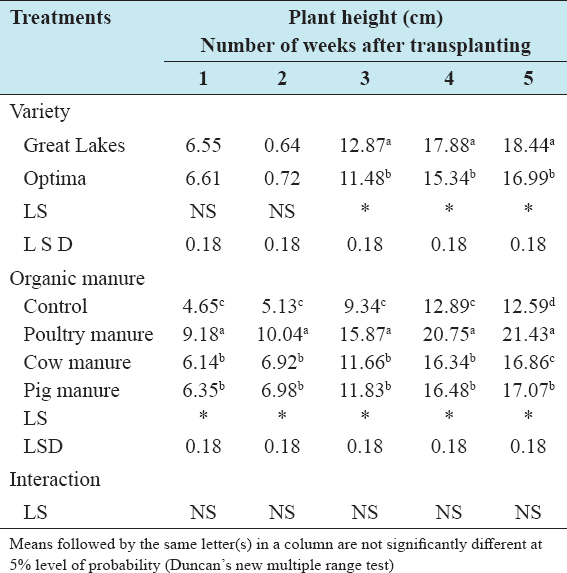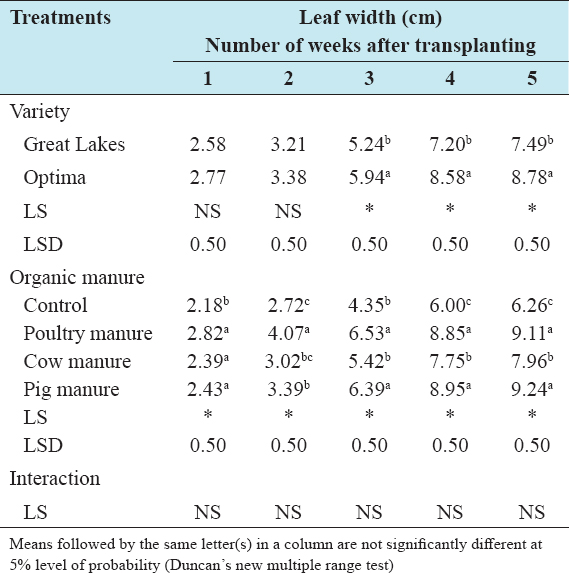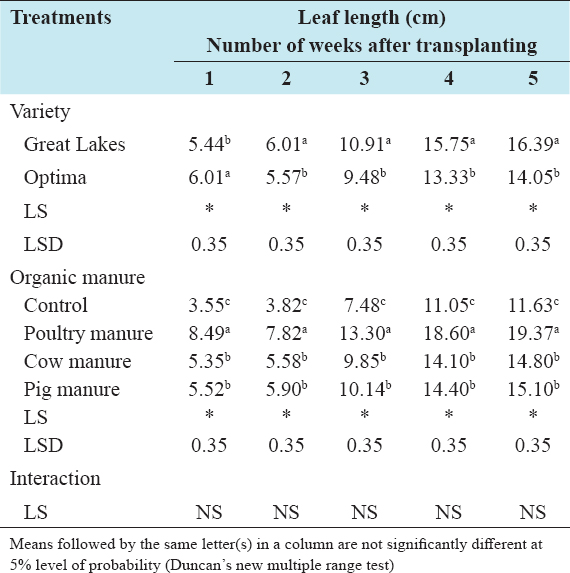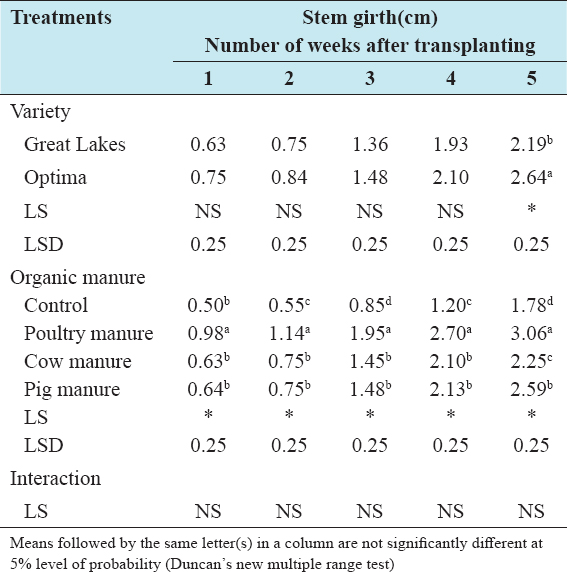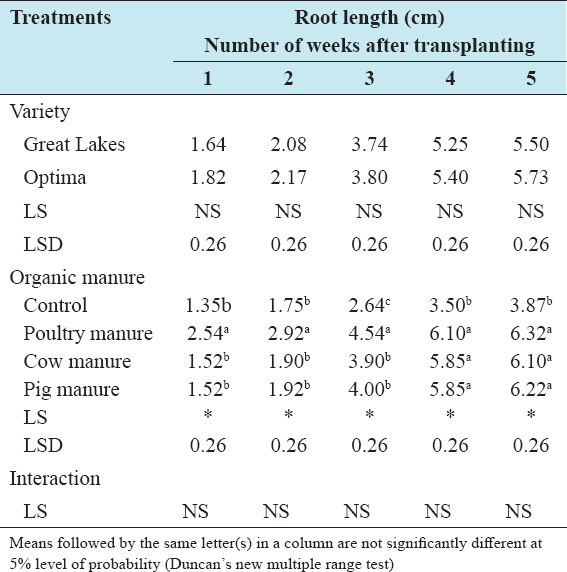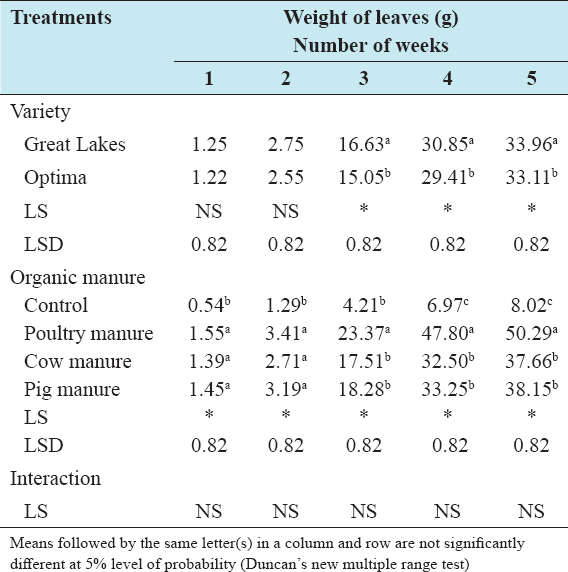RESULTS AND DISCUSSION
Results show that significant differences exist between the organic manures and control with respect to plant height, leaf length, leaf width stem girth, root girth, and weight of leaves. There was no significant difference between the organic manures with respect to number of leaves and root length. However, significant differences exist between the two varieties with respect to plant height, leaf length, leaf width, stem girth, root girth, and weight of leaves. There was no significant difference among the two varieties with respect to weight of leaves, root length, and root girth.
Variety lettuce Great Lakes was tallest in height and was significantly (P < 0.05) different from variety lettuce optima. There was a significant (P < 0.05) difference between the organic manures on mean plant height. Poultry manure showed the highest performance on plant height, followed by pig manure, cow manure, and control in a decreasing order.
There was a significant (P < 0.05) difference between the two varieties. Variety lettuce Great Lakes had the highest number of leaves per plant and the lowest was observed in variety lettuce optima. There was no significant difference between poultry manure, cow manure, and pig manure on number of leaves. Control was significantly different from the three manures and had the lowest number of leaves per plant.
Variety lettuce optima had the highest leaf width and was significantly (P < 0.05) different from variety lettuce Great Lakes which had the shortest leaf width. There was a significant (P < 0.05) difference between the organic manures on mean leaf width. Pig manure and poultry manure were similar but cow manure was significantly different from control. Pig manure had the highest leaf width which was not significantly (P < 0.05) different with poultry manure but significantly (P < 0.05) different with cow manure and control (in a decreasing order of performance on leaf width).
Variety lettuce Great Lakes had the longest leaf length and was significantly (P < 0.05) different with variety lettuce optima which had the shortest leaf length.
There was a significant (P < 0.05) difference between the organic manures on mean leaf length except for pig manure and cow manure which had no significant (P < 0.05) difference. Poultry manure had the longest leaf length, followed by pig manure, cow manure, and control.
Variety lettuce optima had the widest stem girth and was significantly (P < 0.05) different with variety lettuce Great Lakes.
There was a significant (P < 0.05) difference between the organic manures on mean stem girth. Poultry manure had the largest stem girth, followed by pig manure, cow manure, and control.
There was no significant (P < 0.05) difference between the two varieties on mean root length. There was no significant (P < 0.05) difference between the organic manures on mean root length but control differed (P < 0.05) significantly with the organic manures and had the lowest root length. There was no significant (P < 0.05) difference between the two varieties on mean root girth.
There was a significant (P < 0.05) difference between the organic manures on mean root girth. Poultry manure had the widest root girth, followed by pig manure and cow manure which had no significant (P < 0.05) difference and finally control which had the smallest root girth.
Variety lettuce Great Lakes had the highest weight of leaves, which was significantly (P < 0.05) different from variety lettuce optima which had the lowest weight of leaves.
There was a significant (P < 0.05) difference between the organic manures on mean weight of leaves. Poultry manure had the highest performance on plant height and was significantly different from the other manures. Pig manure and cow manure had no significant difference but control was significantly different from all the treatments and had the lowest performance on weight of leaves.
At 3, 4, and 5 WAT, variety lettuce Great Lakes was significantly (P < 0.05) different from variety lettuce optima. Variety lettuce Great Lakes has the longest plant height (18.44 cm) followed by variety lettuce optima (18.44) [Table 1].
Table 1: Effects of variety as affected by different organic manures on mean plant height of lettuce during the 2019 rainy season in Kuru-Jos
There was a significant (P < 0.05) difference between the organic manures on mean plant height. At 1, 2, 3, and 4 WAT, poultry manure which showed the highest performance on plant height was significantly different from the other manures, pig manure and cow manure were similar but control was significantly different from all the treatments and had the lowest performance on plant height. At 5 WAT, all the organic manures had significant differences with poultry manure having the highest performance followed by pig manure, cow manure, and control in a decreasing order [Table 1].
At 1, 2, 3, 4, and 5 WAT, there was a significant (P < 0.05) difference between the two varieties. Variety lettuce Great Lakes had the highest number of leaves (7.75) and the lowest was observed in variety lettuce optima (6.56). At 4 and 5 WAT, there was no significant difference between poultry manure, cow manure, and pig manure on number of leaves. Control was significantly different from the three manures [Table 2].
Table 2: Effects of variety as affected by different organic manures on mean number of leaves of lettuce during the 2019 rainy season in Kuru-Jos
At 3, 4] and 5 WAT, variety lettuce optima was significantly different from variety lettuce Great Lakes for mean leaf length. At 5 WAT, variety lettuce optima had the highest leaf width (8.78 cm), while variety lettuce Great Lakes had the shortest leaf width (7.49 cm) [Table 3].
Table 3: Effect of varieties as affected by different types of organic manures on mean leaf width during the 2019 rainy season in Kuru-Jos
There was a significant (P < 0.05) difference between the organic manures on mean leaf width. At 3, 4, and 5 WAT, pig manure and poultry manure were similar but cow manure was significantly different from control. Pig manure (9.24 cm) and cow manure (9.11 cm) had the highest leaf width followed by cow manure (7.96 cm) and control (6.26) which had the lowest leaf width [Table 3].
At 1, 2, 3, 4, and 5 WAT, there was a significant (P < 0.05) difference between the two varieties. At 1 WAT, variety lettuce optima performed better than variety lettuce Great Lakes on mean length of leaf. At 2, 3, 4, and 5 WAT, variety lettuce Great Lakes had the longest leaf length (16.39 cm) and variety lettuce optima had the shortest leaf length (49.94 cm) [Table 4].
Table 4: Effect of variety as affected by types of different organic manure on mean leaf length during the 2019 rainy season in Kuru-Jos
There was a significant (P < 0.05) difference between the organic manures on mean leaf length. At 1, 2, 3, 4, and 5 WAT, pig manure and cow manure were similar but significantly different from poultry manure and control. Poultry manure had the longest leaf length (19.37 cm) followed by pig manure (15.10 cm) and cow manure (14.80 cm) which had no significant difference. Control had the shortest leaf length (11.63 cm) [Table 4].
At 5 WAT, there was a significant (P < 0.05) difference between the two varieties at on mean stem girth with variety lettuce optima having the largest stem girth (2.64 cm) and variety lettuce Great Lakes having the smallest stem girth (2.19 cm), [Table 5].
Table 5: Effect of different varieties as affected by different organic manures on mean stem girth during the 2019 rainy season in Kuru-Jos
There was a significant (P < 0.05) difference between the organic manures on mean stem girth. Cow manure and pig manure were similar at 1, 2, 3, and 4 WAT but differed at 5 WAT. Poultry manure had the largest stem girth (3.06 cm), followed by pig manure (2.59 cm), cow manure (2.25), and control (1.78 cm) in a decreasing order [Table 5].
At 1, 2, 3, 4, and 5 WAT, there was no significant (P < 0.05) difference between the two varieties on mean root length [Table 6].
Table 6: Effects of variety as affected by different types of organic manure on mean length of lettuce during 2019 rainy season in Kuru-Jos
There was no significant (P < 0.05) difference between the organic manures on mean root length but control differed from the organic manures. At 5 WAT, poultry manure (6.32 cm), pig manure (6.22), and cow manure (6.10) which showed no significant difference had the longest root length. Control had the lowest root length (3.87 cm) [Table 6].
At 1, 2, 3, 4, and 5 WAT, there was no significant (P < 0.05) difference between the two varieties on mean root girth [Table 7].
Table 7: Effect of variety as affected by different types of organic manure on mean root girth of lettuce during the 2019 rainy season in Jos
There was a significant (P < 0.05) difference between the organic manures on mean leaf length. At 1, 2, 3, 4, and 5 WAT, pig manure and cow manure were similar but significantly different from poultry manure and control. Poultry manure had the longest root girth (19.37 cm) followed by pig manure (2.18 cm) and cow manure (2.18 cm) which had no significant difference. Control had the smallest root girth (1.24 cm) [Table 7].
Table 8 shows the effect of variety as affected by different organic manures on mean weight of leaves. Variety lettuce Great Lakes had the highest weight of leaves (33.96 g), which was significantly (P < 0.05) different from variety lettuce optima (33.11 g). There was a significant difference between the two varieties at 3, 4, and 5 WAT.
Table 8: Effects of variety as affected by different types of organic manure on weight of lettuce during 2019 rainy season in Kuru-Jos
There was a significant (P < 0.05) difference between the organic manures on mean weight of leaves. At 4 and 5 WAT, poultry manure which showed the highest performance on plant height was significantly different from the other manures, pig manure and cow manure were similar but control was significantly different from all the treatments and had the lowest performance on weight of leaves [Table 8].
Different organic manures had varying effects on the growth and yield of two varieties of lettuce. Significant difference was observed among the two varieties with respect to plant height, number of leaves, leaf length, leaf width, weight of leaves, and stem girth. Variety lettuce Great Lakes had better performance for most of the parameters than variety lettuce optima. Reference Jilani et al.[18] observed that different varieties perform differently under the same environmental conditions. References Jilani et al., Jilani and Ghaffor[18,19] have also suggested that different varieties may have different morphological and biochemical characteristics that affect the biomass accumulation among different vegetative parts. This agrees with the differences as observed in the performance of the two varieties. Significant differences were observed in the general performance of organic manures on the two varieties of lettuce with respect to plant height, leaf length, leaf width, stem girth, and weight of leaves. Poultry manure had better performance for most of the parameters followed by pig manure, cow manure, and finally control in a decreasing order of performance. The chemical analysis reveals that poultry manure had higher concentrations of the nutrients required for growth and development than is observed for the pig and cow manures. This may have been responsible for the significant differences observed. These differences may be due to the availability of nutrients as affected by the water holding capacity of the soil.[20] Recently, higher yields of lettuce “Veneza Roxa” were reported with poultry manure followed by cattle manure and finally inorganic fertilizer.[13] Increased vegetable yield with the use of organic manures has been reported for Okra.[15]
These results are in agreement with work done in Brazil where chicken manure, compost, charcoal, forest litter, and chemical fertilizer 2:3:2(22) were tested during four cropping cycles with rice (Oryza sativa L.) and sorghum (Sorghum bicolor L.) in five replicates in which the application of chicken manure amendments resulted in the highest cumulative yield.[21] On the contrary, a study was conducted to determine the effects of applying organic fertilizers and inorganic fertilizers on the yield and nutritive value of head lettuce, equivalent yields were obtained regardless of the type of fertilizer used.[22] In another studies with tomato, results showed that two organic fertilizer treatments provided better yield than chemical fertilizers.[23]

